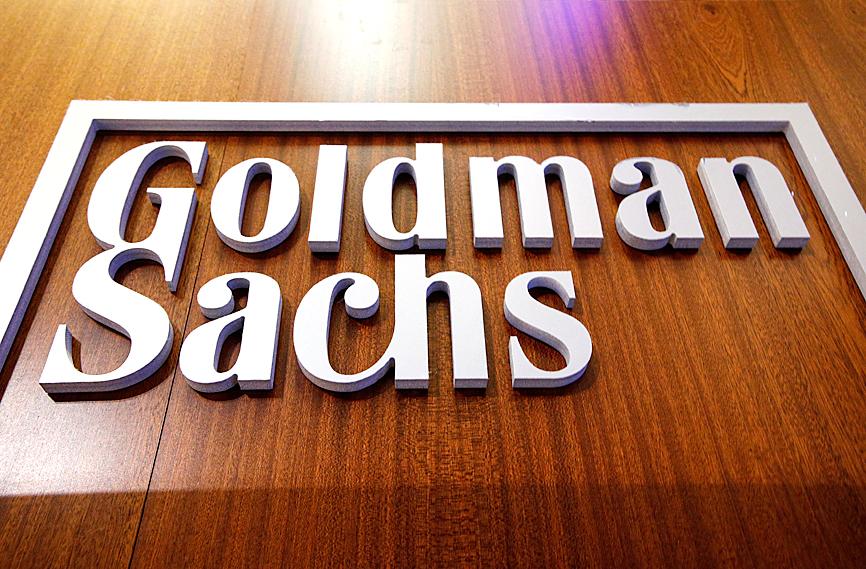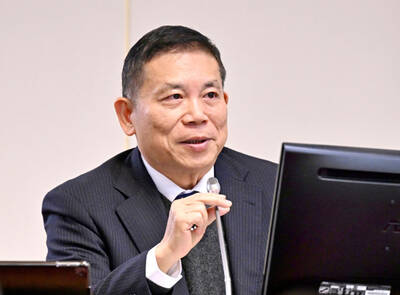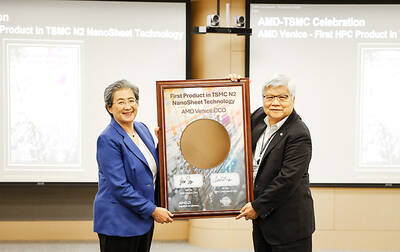Profit at Goldman Sachs Group Inc jumped amid a merger boom, while JPMorgan Chase & Co’s results were boosted by the impact of the recovering US economy on loan quality, according to results released on Tuesday.
The financial heavyweights reported soaring second-quarter profit compared with the previous year, when large banks set aside massive reserves in case clients defaulted amid the COVID-19 downturn.
However, widespread access to COVID-19 vaccines and the accelerating reopening of the US economy have put those days in the rearview mirror.

Photo: Reuters
At JPMorgan, which has a significant retail operation in addition to investment banking, combined debit and credit card spending was up 45 percent from the previous year and more than one-fifth higher than in the pre-pandemic 2019’s second quarter, JPMorgan chief executive Jamie Dimon said.
He highlighted “exceptionally strong” consumer and business balance sheets.
However, the much sunnier outlook includes some continued question marks surrounding the course of the pandemic.
The rapid spread of the Delta variant of SARS-CoV-2 is one factor creating “elevated uncertainty” about the bank’s outlook for “a very robust recovery,” JPMorgan chief financial officer Jeremy Barnum said.
Goldman Sachs chief executive David Solomon also cited the pandemic as a potential source of economic trouble, noting this month’s tightening of restrictions in Hong Kong and Australia.
Vaccine coverage “is not consistent across communities and nations, including parts of the United States,” Solomon said on a conference call with analysts. “Widespread vaccine distribution and high vaccine rates are critical to open and thriving economies.”
The biggest US bank by assets, JPMorgan began the earnings season for the sector, reporting that profit more than doubled to US$11.9 billion in the second quarter, including a boost from US$3 billion that had been set aside as reserves.
JPMorgan had budgeted US$8.9 billion for bad loans in the second quarter last year, but it reported just US$734 million in charge-offs for defaults in the second quarter this year.
However, revenue for the period fell 8 percent to US$30.5 billion, as the bank’s trading business saw much less activity compared with the previous year.
Bank executives also expressed little optimism about loan growth, given the healthy state of US consumer finances following government stimulus programs.
Loan growth is going to be “a little bit of a slog through the rest of this year,” Barnum told reporters.
While “unusually high” pay rates for credit cards are “a healthy thing for consumers, it does create a bit of a headwind for our loan growth,” he said.
JPMorgan posted record global investment banking fees of US$3.6 billion in the second quarter, driven by heavy merger and acquisition activity.
At Goldman, profit came in at US$5.3 billion in the second quarter, compared with US$197 million the previous year, when results were dented not only by provisions for bad loans, but from elevated legal costs.
Revenue was US$15.4 billion, a 16 percent increase and the second-highest quarterly revenue in the firm’s history after the first three months of this year.
Goldman’s results reflected a jump in financial advisory revenue due to a rise in completed mergers and acquisitions.

Taiwan will prioritize the development of silicon photonics by taking advantage of its strength in the semiconductor industry to build another shield to protect the local economy, National Development Council (NDC) Minister Paul Liu (劉鏡清) said yesterday. Speaking at a meeting of the legislature’s Economics Committee, Liu said Taiwan already has the artificial intelligence (AI) industry as a shield, after the semiconductor industry, to safeguard the country, and is looking at new unique fields to build more economic shields. While Taiwan will further strengthen its existing shields, over the longer term, the country is determined to focus on such potential segments as

UNCERTAINTY: Innolux activated a stringent supply chain management mechanism, as it did during the COVID-19 pandemic, to ensure optimal inventory levels for customers Flat-panel display makers AUO Corp (友達) and Innolux Corp (群創) yesterday said that about 12 to 20 percent of their display business is at risk of potential US tariffs and that they would relocate production or shipment destinations to mitigate the levies’ effects. US tariffs would have a direct impact of US$200 million on AUO’s revenue, company chairman Paul Peng (彭雙浪) told reporters on the sidelines of the Touch Taiwan trade show in Taipei yesterday. That would make up about 12 percent of the company’s overall revenue. To cope with the tariff uncertainty, AUO plans to allocate its production to manufacturing facilities in

COLLABORATION: Given Taiwan’s key position in global supply chains, the US firm is discussing strategies with local partners and clients to deal with global uncertainties Advanced Micro Devices Inc (AMD) yesterday said it is meeting with local ecosystem partners, including Taiwan Semiconductor Manufacturing Co (TSMC, 台積電), to discuss strategies, including long-term manufacturing, to navigate uncertainties such as US tariffs, as Taiwan occupies an important position in global supply chains. AMD chief executive officer Lisa Su (蘇姿丰) told reporters that Taiwan is an important part of the chip designer’s ecosystem and she is discussing with partners and customers in Taiwan to forge strong collaborations on different areas during this critical period. AMD has just become the first artificial-intelligence (AI) server chip customer of TSMC to utilize its advanced

Chizuko Kimura has become the first female sushi chef in the world to win a Michelin star, fulfilling a promise she made to her dying husband to continue his legacy. The 54-year-old Japanese chef regained the Michelin star her late husband, Shunei Kimura, won three years ago for their Sushi Shunei restaurant in Paris. For Shunei Kimura, the star was a dream come true. However, the joy was short-lived. He died from cancer just three months later in June 2022. He was 65. The following year, the restaurant in the heart of Montmartre lost its star rating. Chizuko Kimura insisted that the new star is still down